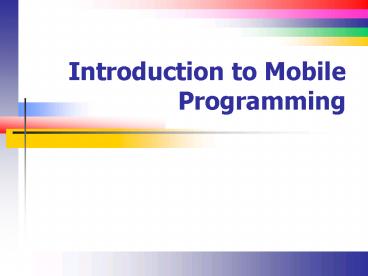Introduction to Mobile Programming - PowerPoint PPT Presentation
1 / 32
Title:
Introduction to Mobile Programming
Description:
Introduction to Mobile Programming Overview Fundamentally, it all works the same way You get the SDK for the device (Droid, Windows, Apple) You get a development ... – PowerPoint PPT presentation
Number of Views:890
Avg rating:3.0/5.0
Title: Introduction to Mobile Programming
1
Introduction to Mobile Programming
2
Overview
- Fundamentally, it all works the same way
- You get the SDK for the device (Droid, Windows,
Apple) - You get a development account to test the
application - You deploy the application
- The APIs are different from one platform to the
next
3
Getting Started (Android)
- Download the Android SDK)
- Use Eclipse as the development environment
(others are possible) - You are really writing Java code here against
another API
4
Getting Started (Android)
5
Getting Started. Android
- The markup is XML
- The code is Java with a different set of
libraries - I have not worked this much
6
Getting Started (Windows)
- You need to get the Windows Phone 7.1 or 8.0
Emulator - Note Windows 8 phone apps can only be developed
on Windows 8 systems - Uses Silverlight 5.x
- Note windows 7.x phone apps can only be developed
on Windows 7 systems - Uses Silverlight 4.x
- Dont try to use any of the server OSs
7
Getting Started (Windows)
- Ill be working with 7.1 here
- Have not played with Windows 8 ?
8
Creating a First App
- When you installed the SDK you should see the
Silverlight for Windows Phone templates - Note that you also need the basic Silverlight
tools too - And the right version
9
Creating a First Windows App
10
Creating a First Windows App
- Select the Target Phone Version
11
Creating a First Windows App
- And the emulator appears
12
What you Already Know
- Its all Silverlight (from last time)
- The IDE is similar to what you know
- Toolbox, visual designer, Code Editor, Properties
Window, Solution Explorer - The debugging tools are about the same
- Some of the user interface elements differ
13
UI Differences
- The TextBlock is the equivalent to a multi-line
text box - The TextBox and Button and other controls work
as you would expect - Note the WPF property namesare much different
14
A First Program
- Create the XAMLusing the designer
15
A First Program
- The XAML produced
16
A First Program
- Create the code behind
17
A First Program
- And just run as usual
- The app appears in an emulator
18
Creating Additional Pages
- Add an item to the to the project as usual (more
about page types in a moment)
19
Navigation Between Pages
- A Windows phone application is made up of pages
- Your first is MainPage.xaml and MainPage.cs
- The hardware back button returns to the
previous page - You use the NavigationService to navigate to the
next page
20
Navigation Between Pages
- Navigate to another page
21
Page Types (1)
- Portrait and Landscape pages should be clear
- Panorama mode uses a container object and you
create panorama items on the page - You swipe between pages (
- Pivot pages work similarly but the title does not
move
22
Panorama Page (Example)
23
Pivot Page (Example)
24
Microsoft Expression Blend
- Its a UI design tool for XAML
- It supports the WPF text engine
25
Microsoft Expression Blend
- Just right click a .XAML file to bring up
Expression Blend - Its a big coloring tool and I dont know it!
26
Phone Event Differences
- You should be used to mouse events (click and
motion) - Now we have touch events (we call these gestures
- Tap
- Multi-tap
- Pinch
- Note that multi-touch events dont work right in
the emulator
27
Phone Events
- Tap / Double tap These are basically equivalent
mouse events - PinchStarted, PinchCompleted, PinchDelta
- These are multi-touch events
- Flick The quick mouse swipe (usually for page
turning - Hold Touch and hold for context menus or popups
28
Deployment (1)
- For testing and any deployment to an actual
phone, you need a Windows Phone developers
account - Free thru Dreamspark but otherwise 99/year
- For production, you need to play the Apple way
(almost) - Microsoft need not approve your application
though - Its possible to unlock (hack) your phone for
testing
29
Deployment (2)
- http//msdn.microsoft.com/library/windowsphone/dev
elop/ff769508(vvs.105).aspx
30
Deployment 3
- Start the Application Deployment tooland select
theXAP file
31
Deployment (4)
- In Visual Studio select the Windows Phone Device
- Phone must be on and connected
32
(No Transcript)































